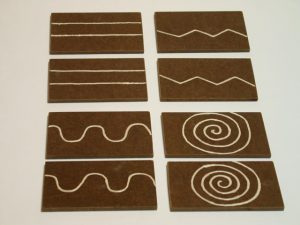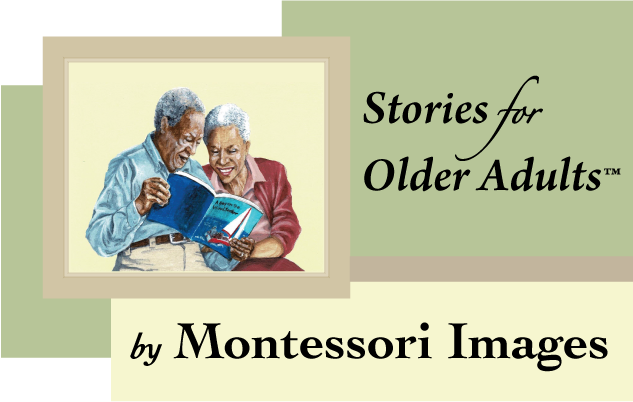Just as the picture book narrative offers a meaningful context for learning language concepts, structures and vocabulary; so, also, picture book art can provide a rich teaching tool for presenting the basic elements of art – line, shape, form, color and texture.
Picture book illustrations are often the child’s first exposure to art. Since story and art work together in the picture book, the art of a favorite story can be very powerful, evoking childhood memories well into our adult lives. Immersed in a story, a child can ponder picture book art with time-defying focus and concentration. This sets the the stage for meaningful lessons on the elements of art.
Here are 3 tried and true ideas for using fictional picture books as examples in the children’s house art curriculum. Of course, this is not meant to diminish their potential for use at all levels of art education – primary and beyond. If you are using picture book art in your art curriculum, at any level, please share an idea with us in the comments section.
 Harold and the Purple Crayon written and illustrated by Crockett Johnson (1955)
Harold and the Purple Crayon written and illustrated by Crockett Johnson (1955)
Elements of art: line, shape
Media: crayon on paper
Harold, is a curious boy who, with his purple crayon, has the power to create a world of his own simply by drawing it. He wants to go for a walk in the moonlight, but there is no moon, so he draws one. He has nowhere to walk, so he draws a path. He has many adventures looking for his room, and in the end he draws his own house and bed and goes to sleep.
Begin w ith do-it-yourself puff paint tablets for a very concrete impression of line; then move on to Types of Lines Nomenclature cards. Read aloud Harold and the Purple Crayon and follow with some “ponder the art” questions: “Follow the lines – describe them. Follow a line that closes into a shape – name the shape. Can you predict what Harold is drawing by the lines and shapes he makes with his crayon?”
ith do-it-yourself puff paint tablets for a very concrete impression of line; then move on to Types of Lines Nomenclature cards. Read aloud Harold and the Purple Crayon and follow with some “ponder the art” questions: “Follow the lines – describe them. Follow a line that closes into a shape – name the shape. Can you predict what Harold is drawing by the lines and shapes he makes with his crayon?”
 The New Baby Calf by Edith Newlin Chase; Illustrator Barbara Reid (1984)
The New Baby Calf by Edith Newlin Chase; Illustrator Barbara Reid (1984)
Elements of art: form, texture
Media: relief sculpture (photographed)
This charming poem about a loving mother cow and her young calf is illustrated with colorful plasticine. Barbara Reid is a world renowned plasticine-relief artist, and The New Baby Calf was her first book in her trademark style. The effects the artist has produced with simple modelling clay are very unique. The lines and details in the clay will be a strong point of interest to children.
After the children have had many experiences with clay and clay tools, read aloud The New Baby Calf. Describe the original illustrations as relief sculpture. This is sculpture in which images are raised against a flat background. Present a tray of coins for children to feel with eyes opened and eyes closed. A coin is a good example of relief sculpture: the inscription, the date, and the figure are slightly raised above a flat surface. Ponder the art questions: “How do you think the illustrator made the pictures? What types of tools do you think the illustrator used?” Explain the technique in simple terms – background first; add layers of objects, people, animals, etc; add details/textures with clay tools. “If you could touch the original relief, what forms (solids) might you feel?”
 The Lion and the Little Red Bird written and illustrated by Elisa Kleven (1992)
The Lion and the Little Red Bird written and illustrated by Elisa Kleven (1992)
Elements of art: color, texture
Media: collage mixed with color on paper
A little bird and a lion are inexplicably happy when they’re together. The bird loves the sight of the lion’s tail, which changes color daily. When the lion brings the bird into his cave, she understands the changes; the lion uses his tail as a paint brush for creating beautiful murals. The bird sings her happiest song for the lion as their friendship deepens.
Kleven’s collages incorporate pastels, ink, paper, and wool. Their beautiful colors, surprising textures, and striking details give emotion and meaning to the story. She is especially successful in depicting the lion’s gentleness and in suggesting the feelings that bond these two, which provides the power behind the story and fuel for readers’ interest.
I love introducing painting to young children with this story because of the joy the lion feels from his creation and the way he shares that joy with the bird. Read aloud The Lion and the Little Red Bird. Ponder the art with these questions: “Name the changing colors of the lion’s tail. Where are these colors found in nature? How do the colors in this story make you feel? Besides paint, what else did the artist use to create the pictures? If you could touch the original art work, what types of things might you feel?”
To keep picture books clean in the art area, you may want to establish a “Ponder the art table” with a book basket or accessible shelf.
